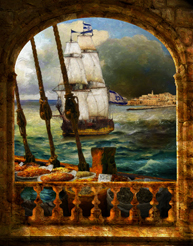 Zebulun / Zevulun זְבוּלֻן
Zebulun / Zevulun זְבוּלֻן
What imageries are included in the depiction of Zebulun?
The artwork of Zebulun features the traditional emblem of a sailing ship. It shows the ancient Port of Jaffa. Jacob said that Zebulun will dwell toward the seashore and that he would be a haven for ships. In the foreground is a vessel filled with premium fish from the sea and local spices of the land. The bright sails stand for Zebulun’s tribal color, which is white or silver. The white and rich blue of the Israeli flag is depicted because it was Zebulun who harvested the chilazon—the beautiful blue dye coming from the sea creature used to color ritual fringes. The Hebrew letters for Zebulun are hidden in the Balusters of the rail.
The Meaning of the Name Zebulun
In Gen. 30:20 Leah said: “G-d has presented me with a good dowry. This time my husband will treat me with honor, because I have borne him six sons.” So she named him Zebulun.” The term dowry is derived from the Hebrew word zvad. Zebulun has also been translated to mean “dwelling,” “habitation,” “abiding,” “continuing,” “living together” and “to reside or dwell with,” from the word zebul, which would make the verse read as: “Now my husband will make his permanent home with me.” It is even stated that it can mean, “He dwells with us,” as in Emmanuel—G-d is with us.
The Biblical Blessings for the Tribe
Genesis 49:13 reads: “Zebulun shall settle the seashores; he will be a harbor for ships; his border shall reach Sidon.” Those words were spoken by Jacob. Moses blessed them in Deut. 33:18-19 by saying: “Rejoice, Zebulun, in your going forth. They shall call the peoples to the mountain; there they shall offer sacrifices of righteousness; for they shall partake of the abundance of the seas and of treasures hidden in the sand.”
Tribal Symbols
A sailing ship or ships on water from Genesis 49:13, “Zebulun will live by the seashore and become a haven for ships.”
Tribal Territory
The tribe of Zebulun inhabited the northern land of Canaan. Both the tribes of Naphtali and Zebulun are mentioned as brave soldiers in the Song of Deborah during the battle against Sisera (Judges 5:18). The tribe of Zebulun traveled and settled on the coastlands. They were as a lighthouse, a guide in the dark, and their place of habitation became a welcome port.
Additional Notes
Zebulun’s name was engraved on the Carbuncle stone, symbolizing lightning, glittering, or flashing. The tribe manufactured glassware from the sand. Perhaps that was the treasures hidden in the sand Moses spoke of in his blessing. The nature of trading in the seaports lead to contacts with other nations. They traveled to Zebulun’s territory out of curiosity and came to visit the mountain where the Temple city was located. Travelers observed the Israelites’ religious rites and were impressed by the unity of Jewish practice—a central worship of one G-d. Some of them converted and that is how the scripture, “they will offer up sacrifices of righteousness,” from Deut. 33:19, was fulfilled.